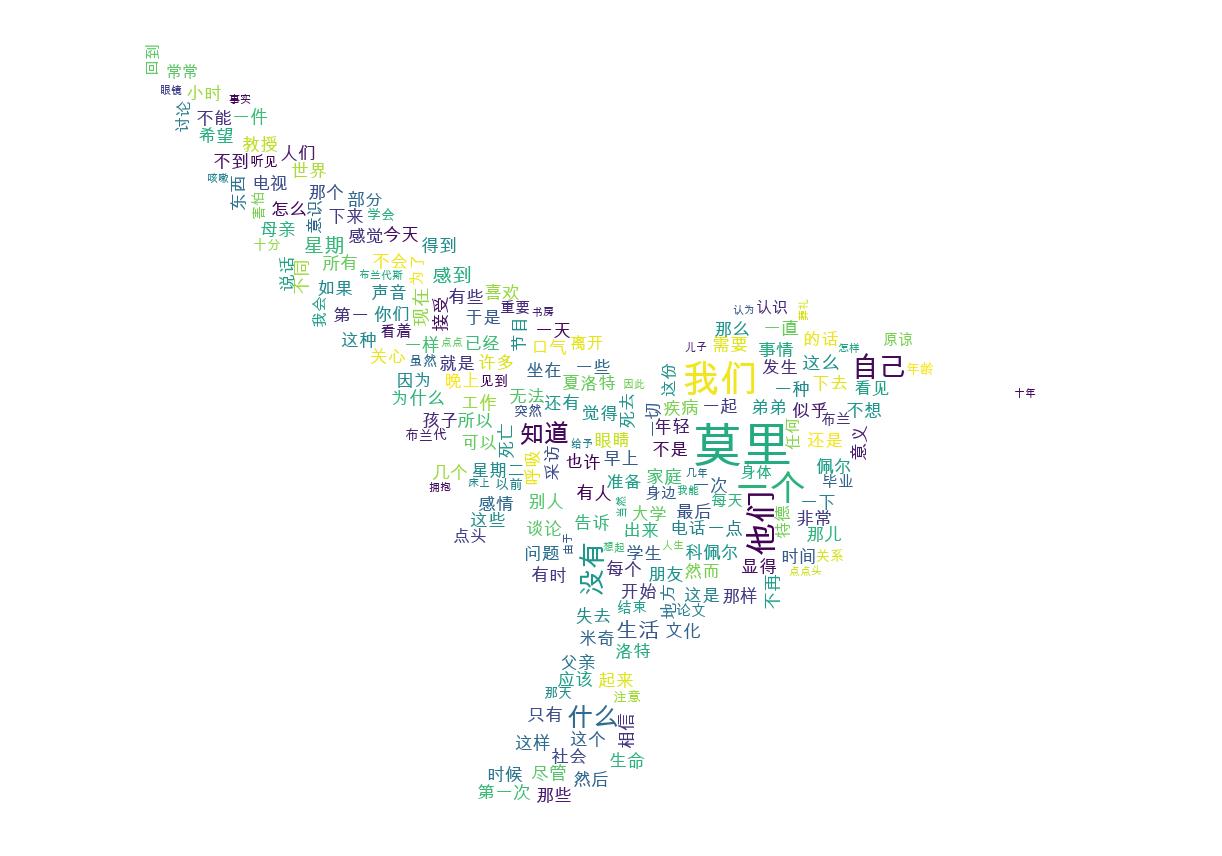这么好看的效果,你知道怎么实现嘛?统计词频并绘制图片——————附完整代码
Posted 繁星蓝雨
tags:
篇首语:本文由小常识网(cha138.com)小编为大家整理,主要介绍了这么好看的效果,你知道怎么实现嘛?统计词频并绘制图片——————附完整代码相关的知识,希望对你有一定的参考价值。
0 效果



1 实现代码
读取txt文件:
def readText(text_file_path):
with open(text_file_path, encoding='gbk') as f: #
content = f.read()
return content
得到文章的词频:
def getRecommondArticleKeyword(text_content, key_word_need_num = 10, custom_words = [], stop_words =[], query_pattern = 'searchEngine'):
'''
:param text_content: 文本字符串
:param key_word_need_num: 需要的关键词数量
:param custom_words: 自定义关键词
:param stop_words: 不查询关键词
:param query_pattern:
precision:精确模式————试图将句子最精确地切开,适合文本分析;
entire:全模式————把句子中所有的可以成词的词语都扫描出来, 速度非常快,但是不能解决歧义;
searchEngine:搜索引擎模式————在精确模式的基础上,对长词再次切分,提高召回率,适合用于搜索引擎分词;
paddle模式————利用PaddlePaddle深度学习框架,训练序列标注(双向GRU)网络模型实现分词。同时支持词性标注。
:return:
'''
# jieba.enable_paddle()
# paddle.fluid.install_check.run_check()
if not isinstance(text_content, str):
raise ValueError('文本字符串类型错误!')
if not isinstance(key_word_need_num, int):
raise ValueError('关键词个数类型错误!')
if not isinstance(custom_words, list):
raise ValueError('自定义关键词类型错误!')
if not isinstance(stop_words, list):
raise ValueError('屏蔽关键词类型错误!')
if not isinstance(query_pattern, str):
raise ValueError('查询模式类型错误!')
# 添加自定义关键词
for word in custom_words:
jieba.add_word(word)
if query_pattern == 'searchEngine':
key_words = jieba.cut_for_search(text_content)
elif query_pattern == 'entire':
key_words = jieba.cut(text_content, cut_all=True, use_paddle=True)
elif query_pattern == 'precision':
key_words = jieba.cut(text_content, cut_all=False, use_paddle=True)
else:
return []
# print("拆分后的词: %s" % " ".join(key_words))
# 过滤后的关键词
stop_words = set(stop_words)
word_count = Counter()
for word in key_words:
if len(word) > 1 and word not in stop_words:
word_count[word] += 1
# res_words = list()
# for data in word_count.most_common(key_word_need_num):
# res_words.append(data[0])
# return res_words
return word_count
绘制图片:
def drawWordsCloud(word_count, save_img_filePath='', img_mask_filePath=''):
# print(word_count)
# print(type(word_count))
if len(img_mask_filePath) != 0:
img_mask = np.array(Image.open(img_mask_filePath)) #打开遮罩图片,将图片转换为数组
wc = wordcloud.WordCloud(font_path='/Library/Fonts/Arial Unicode.ttf',# 设置中文字体,词云默认字体是“DroidSansMono.ttf字体库”,不支持中文
background_color="white", # 设置背景颜色
max_words=200, # 设置最大显示的字数
max_font_size=50, # 设置字体最大值
random_state=30, # 设置有多少种随机生成状态,即有多少种配色方案
width=400,
height=200,
mask=img_mask
)
else:
wc = wordcloud.WordCloud(font_path='/Library/Fonts/Arial Unicode.ttf',# 设置中文字体,词云默认字体是“DroidSansMono.ttf字体库”,不支持中文
background_color="white", # 设置背景颜色
max_words=200, # 设置最大显示的字数
max_font_size=50, # 设置字体最大值
random_state=30, # 设置有多少种随机生成状态,即有多少种配色方案
width=400,
height=200
)
# 绘图
wc.generate_from_frequencies(word_count) #从字典生成词云
plt.imshow(wc) #显示词云
plt.axis('off') #关闭坐标轴
plt.show() #显示图像
# 保存图片
if len(save_img_filePath) != 0:
wc.to_file(save_img_filePath)
else:
pass
2 完整代码
#-*- coding : utf-8-*-
import jieba
from collections import Counter
import paddle
import wordcloud #词云展示库
import matplotlib.pyplot as plt #图像展示库
import time
from PIL import Image
import numpy as np
def timer(func):
def calculateTime(*args, **kwargs):
t = time.perf_counter()
result = func(*args, **kwargs)
print(f'func {func.__name__} coast time:{time.perf_counter() - t:.8f} s')
return result
return calculateTime
def readText(text_file_path):
with open(text_file_path, encoding='gbk') as f: #
content = f.read()
return content
@timer
def getRecommondArticleKeyword(text_content, key_word_need_num = 10, custom_words = [], stop_words =[], query_pattern = 'searchEngine'):
'''
:param text_content: 文本字符串
:param key_word_need_num: 需要的关键词数量
:param custom_words: 自定义关键词
:param stop_words: 不查询关键词
:param query_pattern:
precision:精确模式————试图将句子最精确地切开,适合文本分析;
entire:全模式————把句子中所有的可以成词的词语都扫描出来, 速度非常快,但是不能解决歧义;
searchEngine:搜索引擎模式————在精确模式的基础上,对长词再次切分,提高召回率,适合用于搜索引擎分词;
paddle模式————利用PaddlePaddle深度学习框架,训练序列标注(双向GRU)网络模型实现分词。同时支持词性标注。
:return:
'''
# jieba.enable_paddle()
# paddle.fluid.install_check.run_check()
if not isinstance(text_content, str):
raise ValueError('文本字符串类型错误!')
if not isinstance(key_word_need_num, int):
raise ValueError('关键词个数类型错误!')
if not isinstance(custom_words, list):
raise ValueError('自定义关键词类型错误!')
if not isinstance(stop_words, list):
raise ValueError('屏蔽关键词类型错误!')
if not isinstance(query_pattern, str):
raise ValueError('查询模式类型错误!')
# 添加自定义关键词
for word in custom_words:
jieba.add_word(word)
if query_pattern == 'searchEngine':
key_words = jieba.cut_for_search(text_content)
elif query_pattern == 'entire':
key_words = jieba.cut(text_content, cut_all=True, use_paddle=True)
elif query_pattern == 'precision':
key_words = jieba.cut(text_content, cut_all=False, use_paddle=True)
else:
return []
# print("拆分后的词: %s" % " ".join(key_words))
# 过滤后的关键词
stop_words = set(stop_words)
word_count = Counter()
for word in key_words:
if len(word) > 1 and word not in stop_words:
word_count[word] += 1
# res_words = list()
# for data in word_count.most_common(key_word_need_num):
# res_words.append(data[0])
# return res_words
return word_count
def drawWordsCloud(word_count, save_img_filePath='', img_mask_filePath=''):
# print(word_count)
# print(type(word_count))
if len(img_mask_filePath) != 0:
img_mask = np.array(Image.open(img_mask_filePath)) #打开遮罩图片,将图片转换为数组
wc = wordcloud.WordCloud(font_path='/Library/Fonts/Arial Unicode.ttf',# 设置中文字体,词云默认字体是“DroidSansMono.ttf字体库”,不支持中文
background_color="white", # 设置背景颜色
max_words=200, # 设置最大显示的字数
max_font_size=50, # 设置字体最大值
random_state=30, # 设置有多少种随机生成状态,即有多少种配色方案
width=400,
height=200,
mask=img_mask
)
else:
wc = wordcloud.WordCloud(font_path='/Library/Fonts/Arial Unicode.ttf',# 设置中文字体,词云默认字体是“DroidSansMono.ttf字体库”,不支持中文
background_color="white", # 设置背景颜色
max_words=200, # 设置最大显示的字数
max_font_size=50, # 设置字体最大值
random_state=30, # 设置有多少种随机生成状态,即有多少种配色方案
width=400,
height=200
)
# 绘图
wc.generate_from_frequencies(word_count) #从字典生成词云
plt.imshow(wc) #显示词云
plt.axis('off') #关闭坐标轴
plt.show() #显示图像
# 保存图片
if len(save_img_filePath) != 0:
wc.to_file(save_img_filePath)
else:
pass
if __name__ == '__main__':
pass
# /Users/mac/Downloads/work/retailSoftware/公司项目/test.txt
text_file_path = "/Users/mac/Downloads/电子书/编程思想/相约星期二/相约星期二.txt"
# text_file_path = "/Users/mac/Downloads/work/retailSoftware/公司项目/test3.txt"
text_content = readText(text_file_path)
# print(text_content)
# print(JNI_API_getRecommondArticleKeyword(text_content))
img_mask_filePath = '/Users/mac/Desktop/截屏2021-08-20 下午4.02.10.png'
img_save_filePath = '/Users/mac/Downloads/test9.png'
drawWordsCloud(getRecommondArticleKeyword(text_content), img_save_filePath, img_mask_filePath)
以上是关于这么好看的效果,你知道怎么实现嘛?统计词频并绘制图片——————附完整代码的主要内容,如果未能解决你的问题,请参考以下文章